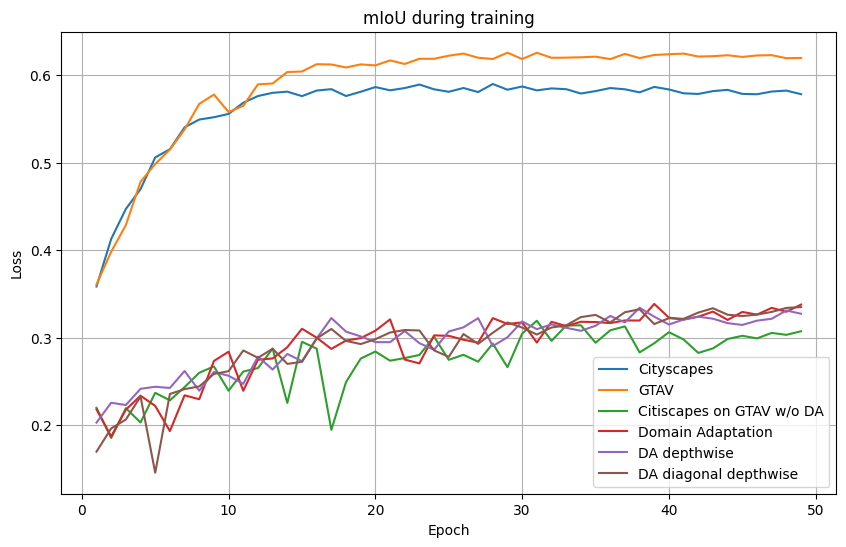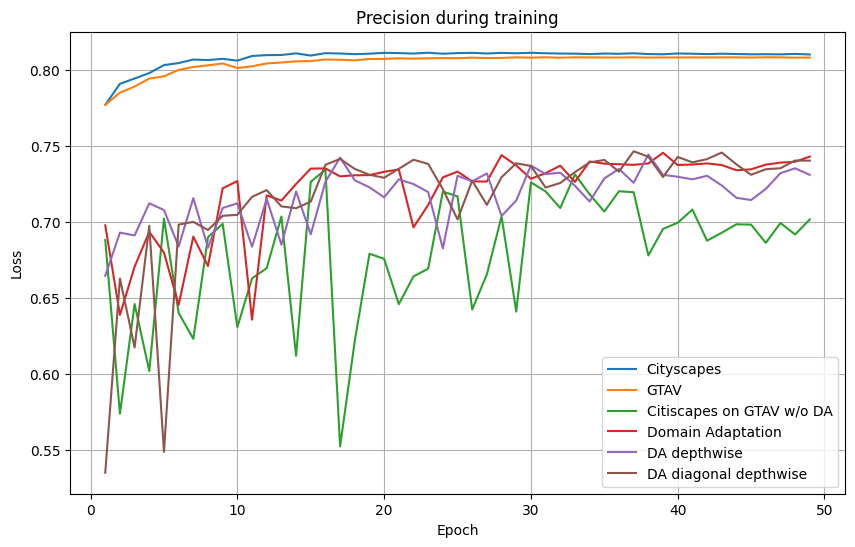Real-time Domain Adaptation in Semantic Segmentation (Course Project)
This repository provides a starter-code setup for the Real-time Domain Adaptation in Semantic Segmentation project of the Advance Machine Learning Course. (Presentation of the project)
- datasets: Contains the dataset classes for the Cityscapes and GTA datasets. The train and validation images for both datasets will also be inserted here.
- model: Contains the STDCNet model and the Discriminator model.
- runs: Contains the tensorboard logs for all the project steps.
- saved_models: Contains the saved models for all the project steps.
- STDCNET_weights: Contains the pre-trained weights for the STDCNet model.
- Download the pre-trained weight at this link at put it in the STDCNET_weights folder.
- Download the Cityscapes dataset and the GTA dataset at this link and put it in the datasets' folder.
- 2.A: Train the STDCNet model on the Cityscapes dataset and evaluate it on the Cityscapes dataset.
- 2.B: Train the STDCNet model on the GTA dataset and evaluate it on the GTA dataset.
- 2.C.1: Evaluate the best model from step 2.B on the Cityscapes dataset.
- 2.C.2: Train the STDCNet model on the GTA augmented dataset and evaluate it on the Cityscapes dataset.
- 3: Train the STDCNet model with unsupervised adversarial training domain adaptation with labeled synthetic data (source GTA dataset) and unlabelled real data (target Cityscapes datasets).
- 4.A: Train the STDCNet model with unsupervised adversarial training domain adaptation with labeled synthetic data (source GTA dataset) and unlabelled real data (target Cityscapes datasets) using a depthwise discriminator.
- 4.B: Train the STDCNet model with unsupervised adversarial training domain adaptation with labeled synthetic data (source GTA dataset) and unlabelled real data (target Cityscapes datasets) using a diagonalwise discriminator.
- 2.A:
--train_dataset Cityscapes --val_dataset Cityscapes --pretrain_path STDCNET_weights/STDCNet813M_73.91.tar --batch_size 8 --num_epochs 50 --learning_rate 0.01 --crop_height 512 --crop_width 1024 --tensorboard_path runs/2_A --save_model_path saved_models/2_A --optimizer sgd --loss crossentropy - 2.B:
--train_dataset GTA --val_dataset GTA --pretrain_path STDCNET_weights/STDCNet813M_73.91.tar --batch_size 8 --num_epochs 50 --crop_height 512 --learning_rate 0.01 --crop_width 1024 --tensorboard_path runs/2_B --save_model_path saved_models/2_B --optimizer sgd --loss crossentropy - 2.C.1:
--mode val --val_dataset Cityscapes --crop_height 512 --crop_width 1024 --save_model_path saved_models/2_B/best.pth - 2.C.2:
--train_dataset GTA_aug --val_dataset Cityscapes --pretrain_path STDCNET_weights/STDCNet813M_73.91.tar --batch_size 8 --learning_rate 0.01 --num_epochs 50 --crop_height 512 --crop_width 1024 --tensorboard_path runs/2_C_2 --save_model_path saved_models/2_C_2 --optimizer sgd --loss crossentropy - 3:
--mode train_adversarial --pretrain_path STDCNET_weights/STDCNet813M_73.91.tar --batch_size 8 --learning_rate 0.01 --discriminator_learning_rate 0.001 --num_epochs 50 --crop_height 512 --crop_width 1024 --tensorboard_path runs/3 --save_model_path saved_models/3 - 4.A:
--mode train_adversarial --depthwise_discriminator depthwise --pretrain_path STDCNET_weights/STDCNet813M_73.91.tar --batch_size 8 --learning_rate 0.01 --discriminator_learning_rate 0.001 --num_epochs 50 --crop_height 512 --crop_width 1024 --tensorboard_path runs/4_A --save_model_path saved_models/4_A - 4.B:
--mode train_adversarial --depthwise_discriminator diagonalwise --pretrain_path STDCNET_weights/STDCNet813M_73.91.tar --batch_size 8 --learning_rate 0.01 --discriminator_learning_rate 0.001 --num_epochs 50 --crop_height 512 --crop_width 1024 --tensorboard_path runs/4_B --save_model_path saved_models/4_B
 Comparative visualization of semantic segmentation results across different models and techniques. Each row shows the original Cityscapes image
with corresponding segmentation outputs. From left to right: the raw image, segmentation without data augmentation and domain adaptation (DA), with data
augmentation but no DA, with DA using a classical convolutional approach, with DA employing depthwise separable convolutions, with DA utilizing diagonal
depthwise separable convolutions, and the ground truth (GT) segmentation. These visual results highlight the progressive improvement in segmentation fidelity
as we move from standard methods to advanced DA techniques
Comparative visualization of semantic segmentation results across different models and techniques. Each row shows the original Cityscapes image
with corresponding segmentation outputs. From left to right: the raw image, segmentation without data augmentation and domain adaptation (DA), with data
augmentation but no DA, with DA using a classical convolutional approach, with DA employing depthwise separable convolutions, with DA utilizing diagonal
depthwise separable convolutions, and the ground truth (GT) segmentation. These visual results highlight the progressive improvement in segmentation fidelity
as we move from standard methods to advanced DA techniques
| Train Datasets | Validation Datasets | Accuracy (%) | mIoU (%) | Train Time (avg per-epochs) |
|---|---|---|---|---|
| Cityscapes | Cityscapes | 81 | 57.8 | 2:33 minutes |
| GTA | GTA | 80.8 | 62.0 | 3:28 minutes |
| GTA | Cityscapes | 60.1 | 24.6 | None |
| GTA augmented | Cityscapes | 70.2 | 30.7 | 5:22 minutes |
| Single Layer DA Source=GTA, Target=Cityscapes |
Cityscapes | 74.3 | 33.8 | 4:33 minutes |
| Single Layer DA Source=GTA, Target=Cityscapes Depthwise discriminator function |
Cityscapes | 73.1 | 32.7 | 4:32 minutes |
| Single Layer DA Source=GTA, Target=Cityscapes Diagonalwise discriminator function |
Cityscapes | 74.0 | 33.5 | 4:25 minutes |
 |
 |
 |
|---|